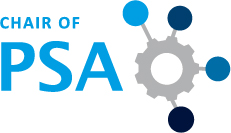Wissenschaftlicher Newsticker Dezember 2016
Introduction of organizational discipline as an essential condition for the achievement of a high level of performance after the change from the singe hand-work assembly to the industrially producing line assembly work using the example of the assembly of wall and ceiling elements for low-energy houses
December 2016 The significance of traditional house construction methods, such as "brick by brick", is noticeably decreased due to the competition between alternative concepts. On account of the relevant decision criteria, such as energy consumption, price and duration of competition, the focus of potential customers shifts in the direction of industrially producing prefabricators, who offer individual concepts. The IAF's long-standing research and development partner, Ing.-Holzbau Schnoor GmbH & Co. KG, decided to expand the product division of the panel construction (the pre-production of wall and ceiling elements) and thus to developed the artisanal production area into an industrial production system. The already successful factory planning, structural realization and technical implementation of the innovative production system led to an interesting research collaboration for the IAF.
Picture: Manufacturing system with a fully automated nailing bridge
The next step on the way to an economically efficient operation of the production system lies in creating a data base for both capacity planning and cost calculation. The IAF employees were entrusted with carrying out a comprehensive data collection to quantify the current performance level of the production system and to determine the temporal relationships between processing time and constructiveness.
The methodical basis for data collection was a work-recording during about two months.
Firstly, the goal and the purpose, which served as a basis for all further steps, were determined. Based on this, the work system was characterized and the activities relevant to the survey as well as the requirements for the precision of the measurement were described in detail. The stations to be analysed were defined as work cycle elements and the respective measuring points of the activities per station were determined. In order to keep the expenses at an economically reasonable level, a camera technology installed in the production system served as a tool for image recording. Due to the full support of the production operators in the application of this technology, a comprehensive recording of the production system was possible. Finally, the statistical evaluation of the collected data with calculation of the basic time was concluded.
Basically, after using the camera, several benefits can be verified:
- the lower analysis effort,
- the temporally and locally flexible survey,
- the possibility to observe the process almost unlimited and thus to clearly understand it.
The disadvantages of this approach are that
- no direct interaction is possible in case of ambiguities and
- the qualitative image representation depends on the camera technology and the installation position.
The superficial goal of creating a capacity planning and calculation basis has been fully achieved. The quantitative data regarding the basic time (pure processing time) are quite satisfactory from the customer's point of view. Furthermore conclusions were drawn about the influence of constructive design features in terms of the processing time. Nevertheless, the applied methodology revealed a large number of deficiencies in the organization of the production system, which could not guarantee an optimal performance of the flow assembly at this time.
In the broader sense of the production systems, the "organization" of such a system implies the provision of all elements necessary for the implementation of the defined work task from an economically reasonable point of view. These elements include the operators, the machines (plant / equipment / tools / handling equipment) necessary for production, the material to be processed and all information and energy flows required for execution. In principle, these elements are required in every production system, independent of the organizational form. However, the structured organisation of these elements in a flow system is much more challenging and complex than other organizational forms. Even the slight(est), organizational deficiencies bring the generally chained system completely to a standstill. A high degree of performance and associated positive (in particular economic) effects of the flow concept (for example, very low throughput times and low or no wait time of the intermediate products) can only be achieved with a high organizational support.
In the case of application, considerable deficiencies were found during the analysis between the pure processing time and the wait time of the intermediate products. The unambiguously identified causes included the failure to fully comply with basic organizational requirements for the operation of a flow system, e.g. a clearly defined division of labor, a robust control concept for material availability, and order by defined places for material and tools and intensive communication in the event of errors. In particular, the above-average high professional competence of the employees led to instinctively self-initiated compensation for many error-influencing factors without their documentation or their lasting elimination. Recurring errors and associated time-consuming on-site solutions were the result. After identification of these weaknesses, measures were taken in cooperation with the employees. A clear division of labor has been defined, a robust control concept has been implemented to ensure the availability of consumption-oriented materials, and employees have been sensitized to compliance with organizational rules and routines. Further measures included the marking of the storages for materials and tools.
Contact: Dipl.-Ing. Gerd Wagenhaus / Dipl.-Wirtsch.-Ing. Varina Neumann






